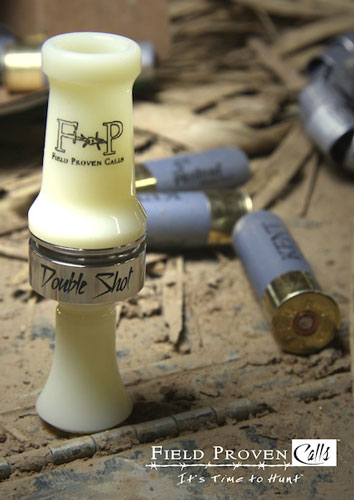 “Choosing a duck call,” said Field Hudnall, “is a lot like buying a shotgun. Or a vehicle. First, you figure out what you can spend — your budget or price range. Next, you look for a reputable company. Maybe a recognized brand; something you’re familiar with. And finally, you take a good, hard look at what you’re genuinely interested in. What’s your skill level behind a call or behind the wheel? What is it you’re really looking for?”
“Choosing a duck call,” said Field Hudnall, “is a lot like buying a shotgun. Or a vehicle. First, you figure out what you can spend — your budget or price range. Next, you look for a reputable company. Maybe a recognized brand; something you’re familiar with. And finally, you take a good, hard look at what you’re genuinely interested in. What’s your skill level behind a call or behind the wheel? What is it you’re really looking for?”
Field Hudnall is the owner of Field Proven Calls (fieldprovencalls.com), maker of fine waterfowl and turkey calls. Atop the competitive stage, the young man’s resume includes contest wins at the 2004 World Championship Live Duck, the ’09 Bass Pro Shops Open Duck, and the 2011 Indiana State Two-Man Duck, along with goose calling championships — the ’05 World Open, and the 2012 North Star Regional, to name but two — almost too numerous to mention. To say the he knows calls is an understatement.
Recently, I was able to corral Hudnall in between consumer shows and ask him one simple, yet complex question: How, with the seemingly infinite number of duck calls available today, does a caller, especially a novice, choose from among the many? With a bit of background information, Hudnall said, the choice becomes much less clouded.
“A reputable call from a reputable company, as I mentioned earlier,” he said, “is very important. It doesn’t have to have been made by world champions, nor does the company have to have the coolest, flashiest advertisements, but they should be established. And they need to have great customer service.”
The first call the young champion purchased, coincidentally, was at a consumer show; a wonderful place for a newcomer to make the initial purchase. “I was able to meet the man who made the call,” Hudnall said. “Shake his hand. Talk to him. Actually try his calls.”
Nice stories, but it still leaves us with the question — which call? Essentially, Hudnall explains that duck calls are created using three variables: material of composition, color, and the number of reeds. Each, he said, has its own unique advantages and disadvantages. Armed with this information, a buyer/caller, particularly a novice caller, can proceed with their purchase with more confidence.
Materials
Wood – “Wood is a very traditional material for crafting duck calls,” said Hudnall. “Wood has a wonderful, rich, raspy sound, but it has its drawbacks. It’s not as durable as some of the synthetics like polycarbonate or acrylic. It’s not indestructible, there’s more maintenance or upkeep involved to keep it in top working condition, and it’s vulnerable to the weather, especially moisture. But wood calls are relatively inexpensive, despite being very labor-intensive to manufacture.”
Polycarbonate – “Polycarbonate material starts as a solid, is melted into a liquid, and then as a liquid is injected into a mold,” Hudnall explained. “Molds are expensive to make, but once the mold is made, the calls themselves are inexpensive to produce. Poly-carb calls are, then, less expensive; they’re a great starter call, and some hunters use them the whole of their career. It’s durable, too.”
 Acrylic – “Acrylic is a great material to work with in terms of sanding and polishing,” Hudnall said. “It’s durable, it’s beautiful, and it’s very versatile in terms of the sounds a caller can produce. It is, however, very expensive, both for the manufacturer and the end-user. Custom calls are often made of acrylic.”
Acrylic – “Acrylic is a great material to work with in terms of sanding and polishing,” Hudnall said. “It’s durable, it’s beautiful, and it’s very versatile in terms of the sounds a caller can produce. It is, however, very expensive, both for the manufacturer and the end-user. Custom calls are often made of acrylic.”
I had always assumed the color of a duck call was a choice of personal preference. Not entirely, said Hudnall. “In acrylics, there is a difference — a tonal difference — between transparent colors and solid colors. Transparent colors are more dense, or harder, and are therefore sharper, crisper, and louder than the softer or less dense solid colors. Is there a difference between a series of transparent colors and a series of solids? Probably not, but for some, color is more than a visual consideration.”
And now, for the biggie: single-reed versus double-reed duck calls. Is one better? “Every call in the world has its place,” said Hudnall. “As a maker of duck calls, I want to make one that everyone loves, but that’s not going to happen. It boils down to personal opinion and what the individual desires from the call itself.”
According to Hudnall, single-reed calls are “very versatile, with a clean, crisp, demanding sound. However, they do require a greater grasp of the mechanics — air control, tongue control and positioning — to operate than do the double-reed calls. Double-reeds, on the other hand, are more user-friendly. Double-reeds come complete with what I call ‘built-in duck sounds.’ That said, though, they don’t have the range or versatility of a single reed. You’re probably not going to win a World Championship contest with a double-reed call, but if that’s not important or not what you’re doing, then a double-reed offers a little of everything. Double-reeds are a great confidence builder for the new caller.”
And as we know, 75 percent of successful duck calling is confidence.






